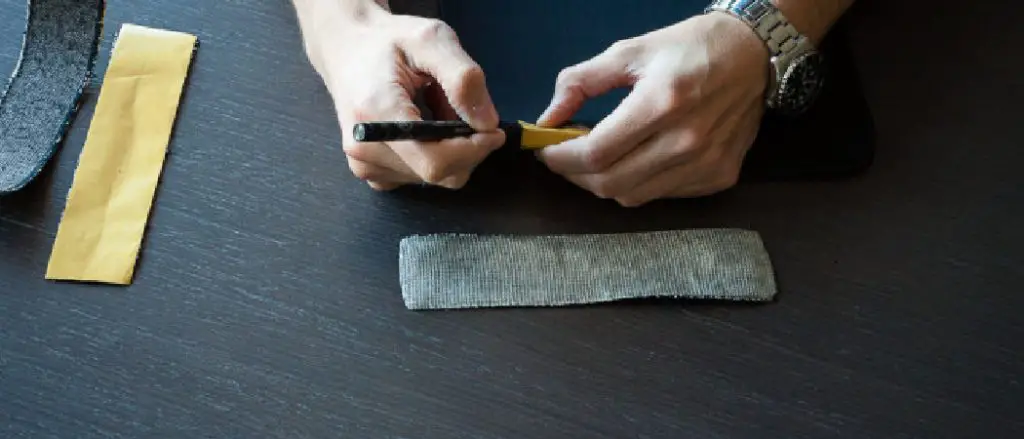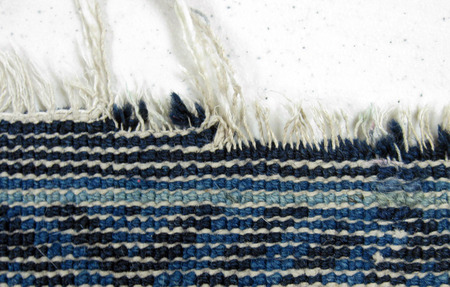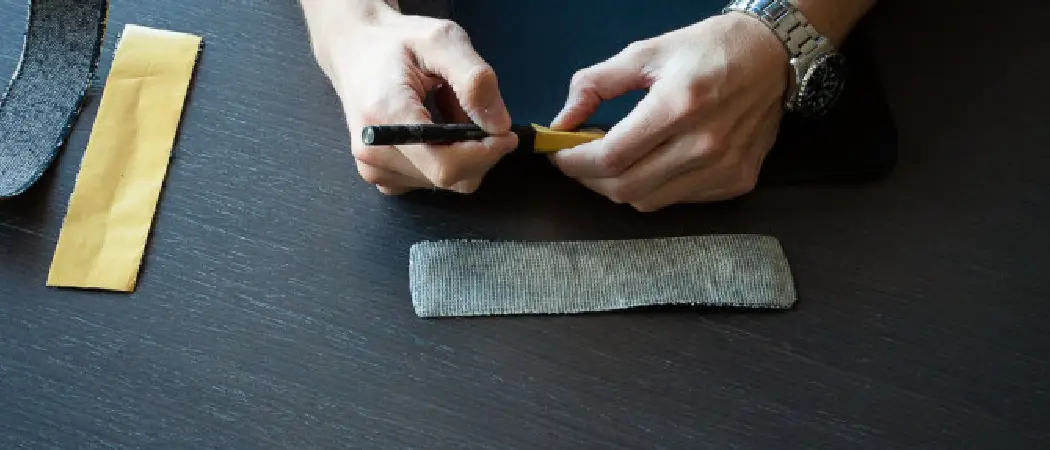To fix a unraveling rug, start by trimming loose threads and applying fabric glue along the edges for reinforcement. You can also stitch the unraveled parts back together for a stronger hold.
Rugs can add style and comfort to any room, but an unraveling rug can be a frustrating sight. However, with a few simple steps, you can easily fix a rug that is starting to come apart. By addressing the issue promptly, you can prolong the life of your rug and keep it looking its best.
We’ll cover some effective methods to repair a unraveling rug and restore it to its former glory. Whether your rug is fraying at the edges or coming apart at the seams, these tips will help you tackle the problem with ease.

Choosing The Right Tools
Choosing the Right Tools is crucial when it comes to fixing a rug that is unraveling. By selecting the proper yarn and gathering the necessary weaving tools, you can ensure a successful repair that will stand the test of time.
Selecting The Proper Yarn
When choosing yarn to repair an unraveled rug, opt for a yarn that closely matches the color, texture, and thickness of the original material. Look for a durable yarn that can withstand the wear and tear of foot traffic and regular use. By selecting the proper yarn, you can seamlessly integrate the new material into the existing rug, creating a cohesive and long-lasting repair.
Gathering The Necessary Weaving Tools
To effectively fix a unraveling rug, gather the essential weaving tools, including a rug hook, tapestry needle, and sharp scissors. These tools will enable you to carefully weave the new yarn into the rug, securing the unraveled sections and blending the repair with the surrounding fibers. Additionally, having a sturdy loom or frame to support the rug during the repair process can make the task more manageable and ensure precise and even weaving.
Preparing The Rug For Repair
To repair an unraveling rug, start by carefully trimming any loose threads. Next, secure the edges with a strong adhesive to prevent further damage. Additionally, consider sewing or weaving to reinforce the weakened areas for a lasting repair.
Cleaning the Area Around the Unraveling Section:
- Vacuum the area to remove dirt and debris.
- Gently blot any stains with a damp cloth.
- Avoid using harsh chemicals that could damage the fibers.
Securing the Loose Threads:
- Identify the loose threads and trim them with scissors.
- Apply fabric glue to the underside of the rug to secure the threads in place.
- Press down firmly to ensure the threads adhere properly.
Starting The Repair Process
Repairing a rug that is unraveling may seem like a daunting task, but with a few simple steps, you can restore your rug to its former glory. The first step in the repair process is identifying the type of weave your rug has. This will help you determine the best method for repairing it. Once you know the type of weave, you can move on to the next step: thread replacement.
Identifying The Type Of Weave
Before you can begin repairing your rug, it’s important to identify the type of weave it has. This will help you choose the right tools and materials for the repair. There are several types of rug weaves, including pile weave, flat weave, and hand-knotted weave.
To determine the type of weave, examine the back of the rug and look for clues. Pile weave rugs have individual fibers that are tufted or knotted into the backing material, creating a plush surface. Flat weave rugs have a flat, woven construction with no pile. Hand-knotted rugs have each knot tied by hand, resulting in a dense and durable weave.
| Type of Weave | Description |
|---|---|
| Pile Weave | Tufted or knotted fibers creating a plush surface |
| Flat Weave | Flat, woven construction with no pile |
| Hand-Knotted Weave | Each knot hand-tied for a dense and durable weave |
Thread Replacement
Once you’ve identified the type of weave your rug has, you can proceed with thread replacement. This step involves carefully removing the damaged threads and replacing them with new ones. To ensure a seamless repair, it’s important to match the thread color and thickness with the original threads.
Start by gently pulling out the damaged threads until you reach a point where the threads are still intact. Then, using a pair of sharp scissors, cut the damaged threads as close to the intact ones as possible. Be careful not to cut into the rug’s foundation or surrounding threads.
Next, take your new thread and thread it onto a needle. Insert the needle into the rug’s backing, following the same path as the original thread. Pull the needle through until the new thread is snugly in place. Repeat this process for each damaged section of the rug, making sure to secure the new threads tightly.
Note: If you’re not confident in your ability to perform thread replacement on your own, it’s best to seek professional help. A rug repair specialist can ensure a proper and professional repair.

Implementing The Weaving Technique
The weaving technique is a tried and tested method for fixing an unraveling rug. By implementing this technique, you can secure loose ends and prevent further damage to your rug. There are two main approaches to weaving: the basic over-under method and advanced techniques for complex patterns.
Basic Over-under Weaving Method
The basic over-under weaving method is perfect for rugs with simple designs or those that have a straightforward pattern. Here’s how you can implement this technique to fix your unraveling rug:
-
Assess the Damage: Examine the rug to determine the extent of the unraveling. Locate the loose ends and identify where the weaving needs to be repaired.
-
Gather the Necessary Tools: You’ll need a rug needle, a heavy-duty thread or yarn that matches the color of your rug, and a pair of sharp scissors.
-
Secure the Loose Ends: Thread the needle with the yarn or thread and insert it at the edge of the unraveled area. Weave the needle over and under the rug’s foundation, essentially mimicking the original weaving pattern. Repeat this process until the loose ends are securely fastened.
-
Cut and Finish: Once the loose ends are properly woven, trim any excess thread or yarn using the sharp scissors. Make sure the cut ends are neatly tucked into the surrounding weave.
Advanced Techniques For Complex Patterns
If your rug has intricate patterns or designs, the basic over-under weaving method may not be sufficient. In these cases, you’ll need to employ advanced techniques to ensure an accurate and seamless repair. Here are a couple of techniques you can try:
-
Matching the Original Weave: Carefully analyze the existing weave pattern and replicate it as closely as possible. Use the appropriate colored thread or yarn to seamlessly integrate the repaired section into the rest of the rug.
-
Rebuilding the Pattern: If the original pattern is too damaged or missing, you’ll need to recreate it. This involves studying the surrounding patterns and using them as a guide to reconstruct the missing sections.
Implementing the weaving technique is an effective way to address an unraveling rug. Whether you opt for the basic over-under method or the advanced techniques for complex patterns, following these steps will help you restore the integrity and beauty of your rug.
Ensuring A Seamless Finish
When it comes to fixing a rug that is unravelling, one of the most important steps is ensuring a seamless finish. A seamless repair not only improves the appearance of the rug but also ensures its longevity. In this post, we will discuss two crucial aspects to consider when aiming for a smooth and undetectable rug repair: blending the repair with the original weave and checking for sturdiness and uniformity.
Blending The Repair With The Original Weave
Blending the repair with the original weave is essential to achieve a seamless finish. Here are some steps to follow:
- Choose the right yarn or thread color that matches the original rug weave. This will allow the repair to blend in seamlessly.
- Identify the pattern and technique used for the original weave. This will help you replicate the same texture and tightness in the repair.
- Start the repair by stitching from the back of the rug with the matching yarn or thread. Make sure to follow the same direction and pattern as the original weave.
- Ensure that the tension of the stitches matches the rest of the rug. Consistent tension will create an even and smooth repair.
- Regularly compare your repair progress with the surrounding weave to ensure uniformity. This will help you make any necessary adjustments along the way.
Checking For Sturdiness And Uniformity
Aside from blending the repair, it is crucial to check for sturdiness and uniformity throughout the process. Here are some tips to ensure a seamless finish:
- Tug gently on the repaired area to confirm that the stitches are secure and withstand slight tension.
- Inspect the entire repair for loose or uneven stitches. Adjust them as needed to maintain uniformity.
- Run your hand over the repaired area to check for any noticeable bumps, lumps, or irregularities. Smooth out any inconsistencies for a seamless finish.
- Step back and observe the repaired rug from different angles and lighting conditions. This will help you spot any areas that need further adjustment for a seamless blend.
By following these steps and techniques, you can ensure a seamless finish when fixing a rug that is unraveling. A professional-looking repair not only restores the rug’s appearance but also preserves its value and functionality for years to come.
Adding Finishing Touches
When it comes to fixing a rug that is unraveling, adding finishing touches is the final step in the repair process. It involves tidying up loose ends and ensuring the repair looks seamless and professional. In this section, we’ll explore the essential steps for adding finishing touches to your rug repair project.
Trimming Excess Yarn
Once the unraveled section of the rug has been rewoven and secured, the excess yarn needs to be trimmed to make it flush with the surrounding pile. Use sharp scissors to carefully cut the yarn, ensuring it blends in seamlessly with the rest of the rug.
Concealing Knots And Ends
After trimming the excess yarn, the knots and ends should be concealed for a polished look. Using a small crochet hook or a similar tool, gently tuck any loose ends and knots back into the woven fabric of the rug. This will prevent them from coming undone and ensure the repair is durable.
Maintaining The Repaired Area
To maintain the repaired area of an unraveling rug, regularly inspect for any signs of new damage and promptly repair any unraveling edges or loose threads. Gently vacuum and spot clean the rug as needed, and avoid placing heavy furniture on the repaired area to prevent further damage.
Maintaining the Repaired Area:
Tips for Long-Term Durability
Regular Maintenance Practices
After repairing a unraveling rug, it’s essential to follow a maintenance routine to ensure the durability of the repaired area. Here are some tips and practices to help maintain the repaired rug for the long term.
Tips For Long-term Durability
To maintain the durability of the repaired area, apply a rug pad beneath the rug to distribute the weight evenly, and reduce friction and wear on the repaired section.
Rotate the rug periodically to prevent uneven wear, particularly if it is placed in a high-traffic area.
Use furniture coasters or pads beneath heavy furniture to prevent the rug from tearing or unraveling again.
Regular Maintenance Practices
Vacuum the rug regularly with a low-suction vacuum to remove dirt and debris without pulling on the repaired area.
Spot clean the rug immediately if there are any spills or stains to prevent them from setting in and causing damage to the repaired section.
Consider professional cleaning services annually to maintain the overall condition of the rug and ensure that the repaired area remains secure.
By implementing these maintenance tips and practices, you can extend the longevity of the repaired rug and keep it looking great for years to come.

Seeking Professional Assistance
When To Consult A Professional Weaver
If unraveling persists after DIY attempts, professional weaver consultation becomes necessary.
Choosing A Qualified Rug Repair Specialist
Look for a specialist with experience and positive customer reviews.

Frequently Asked Questions On How To Fix A Rug That Is Unraveling
How Do I Keep My Rug From Unraveling?
To keep your rug from unraveling, apply a thin layer of fabric glue along the edges. Trim any loose threads or fringes. Use a rug pad underneath for extra support. Regularly vacuum with a low-suction setting. Follow care instructions from the manufacturer.
Can You Unfurl A Rug?
Yes, you can unfurl a rug by simply unrolling it carefully and smoothing out any wrinkles or creases.
How Do You Fix Carpet Coming Up At The Edges?
To fix carpet coming up at the edges, start by re-tucking the carpet into the threshold. Use a knee kicker and carpet stretcher to reattach the carpet. If necessary, trim excess carpet and secure it with carpet adhesive. This should resolve the issue and prevent further lifting.
How Do You Fix A Woven Rug?
To fix a woven rug, inspect it for any loose threads or damaged areas. Use a needle and thread to stitch the loose threads back into place. For tears or holes, apply a fabric adhesive or use a patch to repair the rug.
Gently clean the rug if needed, and avoid excessive pulling or tugging.
Conclusion
To conclude, fixing a unraveling rug can be simple if addressed promptly. By following the steps outlined in this guide, you can restore your rug’s beauty and functionality. Remember to use quality materials and techniques to ensure long-lasting results. Take action today to salvage your beloved rug!

